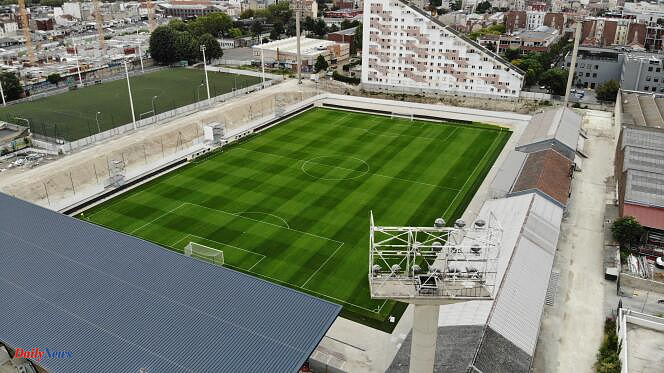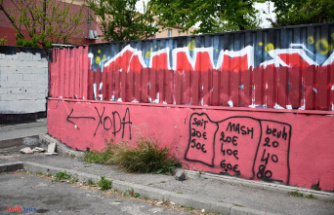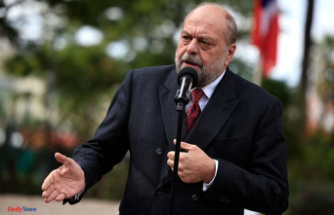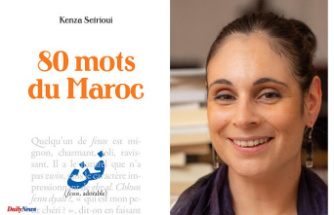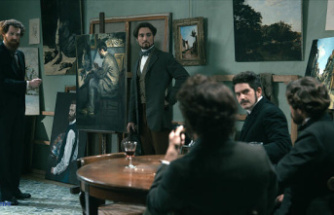From their reinvention between the wars to their glory, the stadiums see their history retraced by the exhibition “Once upon a time the stadiums”, presented at the Cité de l'architecture et du patrimoine, from 20 March to September 16, 2024. Interview on these mythical and symbolic places with the curator of the exhibition, Emilie Regnault.
At the end of the 19th century, sporting activity developed with the popularization of athletics, football and rugby. Sports associations were organized thanks to the law of 1901, which allowed sport to spread to all levels of society. Of course, there were already grounds for amateur practice but the first stadiums – including stands, allowing the public to be hosted and competitions – appeared mainly in the interwar period, often at the initiative of socialist municipalities. , particularly favorable to the practice. In 1936, the Popular Front established the first public sports policy, and supported the development of sports facilities. But we must not overlook the major role of private actors. Among the first stadiums, we can cite the Bauer stadium in Saint-Ouen, inaugurated in 1909, considered to be the first developed French stadium. The Gerland stadium in Lyon by architect Tony Garnier, initiated in 1913 and inaugurated in 1926 following the vagaries of war, is the first major French municipal stadium.
At the beginning of the 20th century, France was a little behind its European neighbors; sport was not yet a discipline shared by the majority. In 1900, to host the Olympiads, the organization had to make do with existing infrastructure, such as the Vincennes velodrome. While for Athens or even London, magnificent stadiums were built. In France, the State is quite reluctant to build “large” stadiums. When in the 1920s, sports authorities argued about the need to build sports spaces, the State then supported local facilities, accessible to all for educational and leisure sports. When the request concerns a large stadium, there is a sort of distrust of “spectacle sport”. The large-scale stadiums that emerged were mostly supported by private investors, like the velodromes for cycling competitions, such as the Parc des Princes (1897, then 1923) or the Vél'd'Hiv ( built in 1909). Remember that the Colombes Olympic stadium is built by the Racing Club.
When the question of stadium construction in France arose at the beginning of the 20th century, there was no real model. Except for references to ancient stadiums or racecourse stands, there are no teachings strictly speaking. When Fine Arts students worked on this program in 1913, they planned a triumphant, grandiose entry but did not address functional and technical questions.
The architecture of stadiums will therefore be nourished by innovations from civil engineering. The use of reinforced concrete, a modern material, is perfectly implemented at the Gerland stadium in Lyon. For its technicality, its capacity to support loads, its plasticity, it was popular in the construction of stadiums until the 1970s. Then, we saw the appearance of plastic covers suspended as in Laval, in stretched canvas in Plémet or as in Villeneuve-d'Ascq through a metal roof held by steel cables. We are then in a quest for performance. The stadium becomes a place of innovation, and even experimentation.
At first, the stands are very basic and not very comfortable; the stands of honor, for notable officials, benefit from a little more comfort. Today, in the majority of cases, the stands are all covered. For large stadiums, differentiation then comes down to the comfort of the seats and the position in the stands. Spaces that can be privatized are appearing. The stadiums close, like arenas, and focus attention on the center, on the lawn.
The stadium will of course be the venue for sporting demonstrations, but also a political and social asset for the modernization of cities. New legislation will encourage the creation of spaces intended for sport. The Cornudet law of 1919 encourages municipalities with more than 10,000 inhabitants to think about and organize the city by integrating the question of sports practice. The stadium is located on the edge of the city, often close to the more popular, industrial areas and far from the congested historic centers. Today, these stadiums are fully integrated into cities but they have contributed to their expansion.
Certain stadiums will play an essential role in the history of cities. This is for example the case of the Bollaert stadium in Lens. In 1933, it was created on the initiative of a private entrepreneur, Félix Bollaert, commercial director of the Compagnie des mines de Lens. Initially, he imagined this stadium for his staff, to promote his own local roots but also to develop the region's sports clubs, like Marcel Michelin in Clermont Ferrand or Raoul Dautry for the SNCF. From 1938, Félix Bollaert made his stadium available to the Racing Club de Lens, the city team, which did not have any specific sports equipment. The stadium was then bought by the municipality, for a symbolic franc, and would become a sort of symbol in the city, with loyal supporters – often former miners – who gathered there.
The first is obviously the Gerland stadium (1913-1926) in Lyon which, for me, lays the foundations of what a modern, monumental stadium dedicated to athletic sports should be. From an aesthetic point of view, the Chaban-Delmas stadium in Bordeaux (1938) embodies architectural prowess with its sublime reinforced concrete veil roof which covers all of the stands. It is with the Parc des Princes (1972) that we move to another dimension. In terms of engineering, this stadium is exceptional because it is partly located on the ring road. It is the first large French stadium where everyone has a seat, where there is an area dedicated to the press. This is the first time that prefabricated (on-site) prestressed concrete has been used for sports equipment. It’s a real aesthetic shock. The Charlety stadium (1986-1994) also imposes a very strong aesthetic. Its mixed structure, of concrete and metal, left exposed, is highlighted. It offers a version open to its environment like the Licorne stadium (1999) in Amiens, with its high structure entirely of glass and metal. Both stand out from completely closed stadiums like the Parc des Princes or the Orange Vélodrome in Marseille.
They are no longer really the same places because the objectives have changed. We are going beyond the stadium with the creation of museums, hotels, shopping centers nearby. Spaces are multiplying to allow more attractiveness and integration into the city. These areas almost become “recreational parks”.
In terms of architecture, priority is now given to the broadcasting of matches, but also concerts. Stadiums become show boxes, which spectators and supporters can attend from a sofa, a cinema room or a fan zone. The quest for the large 100,000-seat stadium is therefore no longer a priority because it is possible to attend the event without being present in the stadium. But it is obvious that the stadium seems to have become, for the older players at least, a monument in its own right.
Find episodes of the “Archi interesting” podcast on “Lemonde.fr” and the listening platforms for a season 3 dedicated to stadiums and produced in partnership with the Cité de l’architecture et du patrimoine.

